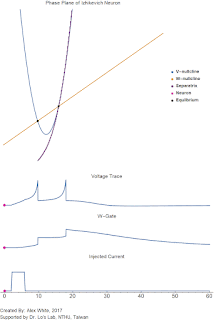Sensory feedback is key in diversity of function, and robustness to external noise
A new paper by Zhuojun Yu and Dr. Peter J. Thomas investigates the importance of sensory feedback in central pattern generation (CPG). These CPGs are critical in any repetitive motor command, such as chewing, walking, running or swimming. A CPG is when neurons periodically fire in a repetitive pattern. For example when any animal walks one group of neurons will fire when the right leg takes a step, and different group of neurons will fire when the left leg takes a step. CPGs neurons will take turns firing in a very precise predictable order and will periodically repeat.
As you can imagine, when walking you cannot just take repeated steps, sometimes something like a rock will get in the way, and you will need to adjust your gate. Perhaps you will need to walk to the right, taking a larger step with your right foot as opposed to the left. Perhaps the ground is slippery from the snow. Regardless of the reasoning, sensory feedback helps keep the CPG firing in a way that is useful to navigate the environment. That is, the feedback helps maintain robust activity in the presence of external noise.
In the paper, the authors build a simple (but dynamically rich) model of
a CPG coupled to a muscular system with sensory feedback. They find two
things: Increases in feedback strength increase robustness to external
noise, but decrease the robustness to internal noise, and second the CPG
with sensory feedback has more functions (behaviors) than the CPG
without sensory feedback.
The first observation makes intuitive sense, that more feedback will allow the CPG to better respond to the environment. However, whats a bit more counter-intuitive, is that the system's own internal noise gets amplified. Intuitively, you can think about this any internal jitter in the CPG will cause a misalignment in the feedback system, and it will erroneously amplify this noise. Thus, it is imperative that organisms balance their sensory feedback with the internal strength of the CPG, as to be able to optimally handle both internal and external noise.
The second take away from the paper is that sensory feedback increases what patterns the CPG is able to perform. With strong feedback, there exists asymmetric patterns. This is due to a underlying supercritical pitchfork bifurcation that we have discussed previously. You can conceptualize this as a stable cycle splitting into two asymmetrical cycles that are mirror copies of each other. Behaviorally this can be thought of walking rightward or leftward. The walking gate is inherently asymmetric, nut there exists two versions of the behavior.




留言
張貼留言